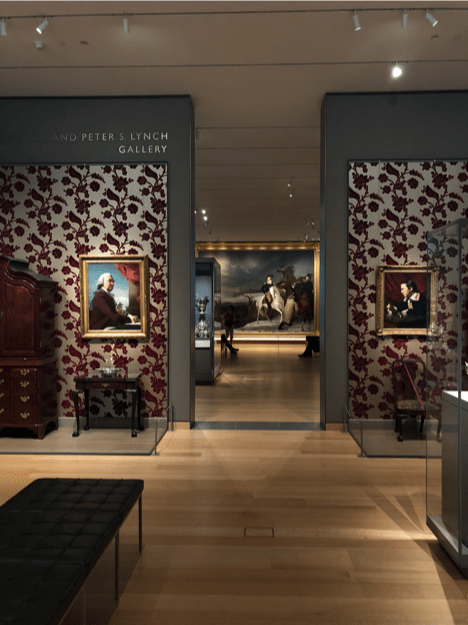Introducing Sherlock ‘Helms’
by: Danielle Kronmiller

My color-coded note packet containing the locations of and information on the remaining accessions inventory
Approaching the halfway point of my internship with Boston National Historical Park, the progress of the collections inventory has surpassed that mark across the three sample lists – controlled property, random sample, and accessions. All in all, by my best estimation, I have helped physically locate more than 700 items in the collections so far! The controlled property and random sample inventories are generally straightforward and are growing nearer and nearer to completion, which is a very satisfying bit of progress. The accessions portion of the inventory has proven to be the most challenging, and therefore most stimulating part of the inventory process. As it turns out, collections inventory can feel quite like detective work at times, and I am starting to feel a bit like a bonafide Sherlock ‘Helms’. Navy Yard? Ship puns?…Forgive me?

A list of over one hundred catalog numbers for an accession of battle helmets from the USS Cassin Young. Each one has to be located!
The accessions inventory, by its nature, does not always include catalog numbers for items or straightforward location information. Some accessions are only partially cataloged (sometimes not at all), very large, or stored in different locations – or even partially cataloged, very large, AND stored in different locations. This is when accession files and catalog cards, which I mentioned in my first post, become even more precious. Typically, my day as an intern consists of a continuous process of alternating between physically locating items and doing research on their location to facilitate this. Sometimes, the curator and I will check a location that is supposed to house a specific item, but the object in question is nowhere to be found. When this happens, I go back in to records and notes, further researching other possible locations; occasionally, a location will be listed incorrectly in the computer, but is accurate on the catalog card, and vice versa. All of these discrepancies are noted and corrected on the inventory lists, and it is always very satisfying to finally check off a particularly difficult accession as ‘found’! This process of continuous research and cross-reference predictably generates an impressive amount of handwritten notes, but – as my stack of notes continues to grow and my pencil continues to shorten – each successful location brings us one step closer to completing the annual inventory!

Looking small, but lovely, among modern skyscrapers, the Old State House was once one of the largest and most imposing buildings in Boston
Since my last post, I have made many more visits to other cultural sites around Boston. Though they all stand out, I wanted to highlight a few more that left a particular impression. First to come to mind is the Old State House, where the Declaration of Independence was first read to Bostonians in 1776 and outside of which the Boston Massacre occurred. It is now operated as a museum with well-done exhibits chronicling the early revolutionary history of this nation. However, what particularly struck me was an exhibit on the top floor that dealt with the major question that is often posed to museums and historic sites: why is this being preserved? It addressed the various things that make particular items ‘worth’ the cost and effort of conserving and interpreting them, and noted that, for many of the significant historical sites around Boston, it has often been the initiative of the community that has ensured their survival. For me, it served as an inspiring reminder of the value of the career I have chosen to pursue!
I also visited the National Park Service’s own Bunker Hill Museum and, yes, climbed the monument – all 294 stairs (worth it, but I’ll spare you the exhausted selfie!). The interpretation of the exhibits in the museum is fantastic, but I particularly enjoyed seeing items from BNHP’s collection on display, putting the work I am doing on the collections inventory into a more public context. Further on in the inventory process, I will be back at the Bunker Hill Museum, as many of the objects on display appear on the lists!

Partial view of the exhibit on the Battle of Bunker Hill on the second floor of the Bunker Hill Museum. The exhibits on the first floor focus on the monument and the history of Charlestown. The Bunker Hill Monument always makes for an impressive picture – and a great navigational point!
I want to mention one final visit before signing off for now – the Museum of Fine Arts, Boston. All of my previous visits in the area had been to historical museums and sites, so I really enjoyed the fresh experience of discovering such an extensive fine arts collection. I spent an entire day making my way through the many galleries, viewing art from all over the world. The MFA has a particularly impressive collection of American art, much of it to do with Boston and its revolutionary history. This made me think about the numerous ways different museums and collections create unique experiences for visitors. Individuals can have a more personally meaningful learning experience when looking through different lenses; one person may prefer a tour of the USS Constitution, while another better appreciates a painting of the famous ship out at sea. Museums of all kinds offer such a variety of experience, and I am so grateful that I have to opportunity to explore the incredible sites and institutions of Boston.



